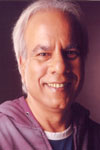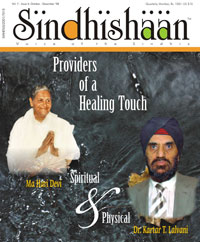THE COLUMN – L.I.T.E.R.A.T.U.R.E. S.P.E.C.I.A.L.
By Arun Babani

Literature is as old as man. In the beginning it was the spoken word which came down to us as folk literature. The ideas and themes were quasi-religious, and were moral tales about good and bad, right and wrong. Literature as it is known today was born in the early 19th century and was later known as Realism. This consisted of stories of artists based on real life. 20th century witnessed many new and modern viewpoints in literature. Realism of earlier times gave way to surrealism which was the result of the artists and writer's boredom and aversion to real life stories. Surealism sought to look at the hidden side of life around dreams and fantasies. Later, around 30's and 40's existentialism trends in arts and literature came to be known. These trends were the direct result of wars and man's seeming purposelessness of life. Jean Paul Sartre, the foremost exponent of Existentialism literature, explored dreams and inner feelings and was influenced by Sigmund Freud's psychoanalysis. Other writers of this genre were Fraz Kafka, Albert Camus and so on. Then came Absurdist literature which was an offspring of existentialism. Samuel Beckett's 'Waiting for Godot' was an example of Absurd literature and he was awarded the Nobel Prize for literature. Later, one more trend, known as Magic Realism came into fashion. Gabriel Garcia Marquez's 'One hundred years of solitude', which also won the Nobel Prize for literature, was the exponent of Magic Realism in literature. By the 1980's and 90's literature began to feel the impact of TV and internet. Some even proclaimed the death of the novel. The written word, all over the world suffered because of the advent of cable TV. Today, in the beginning of the 21st century, two trends are seen emerging in the written word. On the one hand there are the Journalistic accounts of civilizations and realities and on the other hand a new genre of self-help books are becoming popular. So in a way literature has come full circle, from the Realism of the last century to the Realism of toady, with only one difference: The accounts of reality in the world have been more thoroughly researched and rechecked. In India most of the best selling authors are journalists – Arun Shourie, M. J. Akbar, Shobha De, even this year's booker prize winner, Arvind Adiga is a journalist with 'Time'.
------------------------------
The Sindhi writer's community is a small circle of close friends who have been together and have known each other for over fifty years. The writer's Directory, brought out by Akhil Bharat Sindhi Boli Ain Sahit Sabha counts 204 Sindhi writers. Add to this figure some more categories of artists like the singers, musicians, actors etc. and you get a figure of 500. These five hundred artists are the intellectuals of the community; know each other closely and the reason they are able to keep in touch is through Sindhi publications. There are 3 prominent Sindhi publications. All of these are quarterly journals devoted to Sindhi literature. There is 'Rachna', brought out by Indian Institute of Sindhology, edited by Lakhmi Khilani and has completed 27 years of publication. There is 'Koonj' edited till recently by Late Shri Hari Motwani and now being published by Nand Chugani and is celebrating its 50th year. Then there is 'Sipoon' under the editorship of Shri Thakur Chawla which has been in print for over 20 years. All these three distinguished journals have one aim in mind, to promote and preserve Sindhi literature and language. All these reputed journals, besides publishing the finest original Sindhi literature, also publish works of writers and poets from Sindh. They maintain close contact with Sindh and even organize seminars and interaction with Sindhi writers across the border.
Apart from these three a mention must be made of one more, although a smaller weekly publication - 'Sindhi Times' ably edited by Shri Narain Bharati from Ulhanagar. 'Sindhi Times' is in its 47th year of uninterrupted publication, which has been achieved single handedly by Mr. Bharati. Lastly there is the 'Hindu' daily, edited by Kishin Varyani, which is published simultaneously from Ajmer, Ahmedabad and Mumbai.
There are many other smaller publications, which have been printed over the years and deal with local issues of the Sindhi community, but the afore mentioned 4 or 5 journals are national level projects and valued and admired by the Sindhi community, at large.
------------------------------
Renowned Sindhi poet Shrikant Sidaf relates of an incident that happened not so long ago. Asha Chand, the producer of TV serials was in Dubai, recording the community anthem , 'Andhi mein jyot ………' in a recording studio. She confronted a problem about some Sindhi word and contacted Sidaf, who was then in Dubai and requested him to come over to the Studio and help solve the problem. In the meanwhile, Uttam Saab, Asha's father, from Mumbai, insisted that one stanza of the anthem be deleted. The stanza in question went something like this : “Sindhis will learn Bengali in Bengal, Malayalam in Kerala, Gujarati in Gujarat, yet they will have Sindhi close to their hearts!” Uttam Saab did not agaree with the spirit of such words and the stanza stood cancelled even without the consent of its author Dr. Moti Prakash, Sidaf's father.
Uttam Saab was well known for his authority in the community. His commitment to the community was total and could not be shaken by the changing realities. In this lay his weakness as well as his greatness. Weakness because he refused to change with the times and greatness because he never ever compromised for the sake of his community. His communist upbringing had made him a solid rock who fought for his values and refused to be waylaid by new fashions in society as well as in literature. Many other Sindhi writers in the long run proved to be opportunistic but Uttam Saab's personality remains towering for his honesty and integrity, in the Sindhi writers community.
------------------------------
The worst calamity of modern lifestyles is that our concentration span has shrunk to the bare minimum. With the barrage of information passing our eyes and brains almost every second, we don't seem to be able to hold on to any one piece of input long enough to imbibe its content and meaning. And the very first causality of this state of affairs is the written word. Take newspapers every morning. They become thicker by the week, with supplements added every day, so that we cannot hold our interest for more than a few seconds on any of them. Take TV in the evening. With over 100 channels to choose from, each channel changing images by the minute, our eyes have become shifty and restless, with the result most to the time we senselessly switch channels in the hope of finding some meaning! Amidst all this frenzy of information, the written word has taken a back seat. And we reject anyone not telling us our story in our language and in our style. There is a crises of information, whether in printed word, moving image or internet blog. Although man is what he is because of information, but he also feels burdened and overloaded by it. A huge school bag carried by a toddler is a ghastly sight telling us about our culture. This overbearing word load has made everyone loose interest in reading and writing. People stop reading because honesty and simplicity has gone out of books. What remains is just a clever play of words which instead of sharing the experience of reality only try to present the smartness of the wordsmiths.
------------------------------
The decades of 60's and 70's are considered the golden period of Sindhi literary movement in India. Sindhi Adabi class, started by the doyen of Sindhi literature - Late Shri M. U. Malkani, at his residence in Churchgate, was later shifted to K. J. Khilnani High School, Dadar. During these weekly literary meets, 50 to 60 young and rebellious writers met over cups of Irani Chai and held passionate discussions. The writers read from their works which were analyzed and then followed by deep and fiery arguments. It was the time of resurgence of Sindhi literature with countless publications, periodicals, journals and magazines. All through these 3 decades Sindhi writing grew and became mature enough to face competition from national and international writers. Literary Sammelans were yearly events which were attended in thousands by the enthusiastic crowds of Sindhi populace. Then there were Kavi Sammelans, Mushairas, Drama Festivals and Bhagat Festivals happening all the time. The forerunners of such tremendous energetic movements were the Trimurti of Sindhi literature, Malhi, Uttam and Kirat. There were many others, no less important names in that movement. Slowly through the eighties and beyond, the fire began to cool, the movement began to tire and today there is not much happening, compared to that golden period. That time lives on forever in Sindhi history as the most momentous period of Sindhi literature.
------------------------------
'Today, at times, I feel that a black cloud will devour me any moment. I feel I have neither been true to my writing nor to my art. Although sometimes I do see some light but there is something that falls from my trembling palms as soon as I try to hold it. In my waking hours I have been closer to books rather than life, so I am always watching the horizon rather than looking around myself. During my youth I would often fall silent for days together. I would not be able to utter a single word. I would wear such an expression on my face that nobody would come close to me. Then after a while I would start crying in a silent room and only then my mind would feel lighter and I would then behave like a normal man.'
These lines of self-analysis are from the pen of one of the profoundest writers and finest human beings in the Sindhi community, Late Shri Krishin Khatwani. He was a tender and sensitive writer and poet who lived in Indore for most of his life time. He spent 4 years in Shantiniketan during his younger days. His work contains sensitive characters, often romantic personalities and his unbroken bond with mother Sindh. He visited Sindh in later life and even wrote memoirs about the visit. Among many stalwarts of literature in Sindhi community the name Krishin Khatwani seems to stand far above others for his depth of perception, emotional charge and intellectual honesty.
The Indian Institute of Sindhology, Indore chapter, recently organized a 3 day seminar on Late Shri Krishin Khatwani. The seminar was well attended by Sindhi intellectuals, professors, poets. Many papers were read and passionately discussed during the seminar. In the evening each day, a short play was staged. Participants included Shri Mohan Gehani, Vashev Mohi, Indra Shabnam, Shri Lakhmi Khilani, Maya Rahi, Rashmi Ramani, Dr. Duru Tanwani, Prof. Sushila Rohra, Prof. Sarita Sharma, Ms.Meena Ramchandani, Dr. Kamla Goklani and many others. The large presence of Sindhi women intellectuals made the seminar successful and memorable.
------------------------------
My friend, the renowned English poet Adil Jusssawalla tells me, 'You Sindhis really do pamper your writers a lot. We, in our Parsi community don't have any of these awards, funds and prizes for our artists!' True. Mr. Jussawalla. Our Sindhi community has over six full fledged state Sindhi Sahitya Acadamies which dole out cash prizes and funds for writers. Then we have NCPSL with a whopping one crore annual budget for Sindhi language and culture. Plus there are numerous Sindhi organizations, big and small, which provide funds for various cultural projects including literature. Each offers awards and funds for writers and artists. But, asks Mr. Jussawalla, 'Does all this make a difference to the artistic sensibilities of the artists. I mean, do you see any growth, any maturity in the works produced?' I wonder. Sindhi writers forever feel a lack. A lack of recognition, a lack of funds, a lack of readership, a lack of good book reviews, a lack of quality in writing . . . . . . . So where has all this patronage led the Sindhi writer?
------------------------------
Officially there may be a dozen or so young Sindhi writers in the community but actually I cannot count beyond three. There is Shrikant Sidaf in Mumbai, Vimi Sadarangani in Adipur and Vinod Assudani in Nagpur. All three write poetry and at times a research paper or so. And when I say young, all three must be (I'm not definite) over 35 years of age. Beyond these three names, if there is any Sindhi writer around, he must be surrounded in mystery. This is about the writers. And what about the readers among the Sindhi youth, the young readers? They may be even less than three! All the readers in the community are on the other side of 60. Community elders still hope for the second coming of their messiah – their mother tongue. There has been no Sindhi education for well over 20 years now, this is the case at least in the big cities. So to have found two or three Sindhi young writers is actually good news. More writers in the 20 to 30 age group would be greater news!
------------------------------
Literature for children in the Sindhi community is far less than required. In fact with two exceptions there are virtually no children's writers among Sindhis. Dr. Hundraj Balwani has done some pioneering work in writing and publishing Sindhi stories for children. He even brought out a regular magazine for children. Vimi Sadarangani too, has written a few books of children's stories which were well received. Apart from these there is not much known about children's literature in Sindhi.
Similar is the case of Sindhi folk literature. In the beginning, just after partition, there were many volumes of Sindhi folk tales. Shri Kirat Babani had put together many Sindhi folk stories in a volume for Sahitya Academy. I also remember a book of history of Sindhi folk tales by Dr. Narain Bharati. But there has been no mention of Sindh folk tales since a long time now.
This genre of literature, both children and folk, must be encouraged so that Sindhi language and culture flourish.
------------------------------
If they can operate a knife and a frying pan in the kitchen, they can also operate huge ideas on paper; if they can mix salt and sugar in cooking, they can also cook up spicy stories; if they can change nappies and prepare tiffins they can very well prepare great food for thought! They are sharp, they are subtle, they are sensitive, they are Sindhi women writers; the tribe that has grown from 3 or 4 in the 50's to 25 or so in the 21st century! In the beginning we had the Trimurti of Sindhi women writers, Ms. Popati Hirananadani, Ms. Sundri Uttamchandani and Ms. Kala Prakash, the trio that captured the imagination of young Sindhis with their fiery, firebrand works. With time, more Sindhi women took up the pen. There was or is Indra Vaswani, Maya Rahi, Rita Shahani, Indra Shabnam, Ratna Godhia, Aruna Jethwani, Kamla Goklani, Ishwari Jotwani, Rukmani Chainani, Rashmi Ramani, Daya Jashnani, Paru Chawla, Tara Mirchandani, Veena Shirangi, Meena Ramchandani, Vimi Sadarangani, . . . . . . . . The list as you can see, is long and all these distinguished ladies are well versed in Indian as well as international literary trends. Most of them have been teachers, professors, doctorates. Their writings reflect (mostly) the plight of women in India, who are subjugated, enslaved by men and their society. These writers are liberated, full of ideas or rebellion. Most of them belong to the middle class and their work is about the social setting, with family values, social norms and moral order.
Sindhi community is proud to have so many talented and sensitive women writers in their midst.
------------------------------
And finally a graceful mention must be made of some great Sindhi souls from the business world, who have over the past 50 years, helped and supported Sindhi literature. It is because of these few that Sindhi literature survives till date. In the previous years, it was the name of Shri Ram Dadlani which was carried at the back cover of every book published in Sindhi. His name came to be held with respect and admiration in the community. Later, Shri Murij Manghnani along with his able son Shri Chander Manghnani took upon themselves the mantle to help, support and promote Sindhi literature. With them there were a few other NRI's who keep their doors open for Sindhi writers and artists. Notable among these are Shri Notan Tolani and Shri Lal Hardasani, both from Hong Kong, and a few others. Here in Mumbai Shri Ramesh Tulsiani has been donating generously to support Sindhi books and periodicals. The community must honour these souls who have stood by Sindhi literary efforts.



